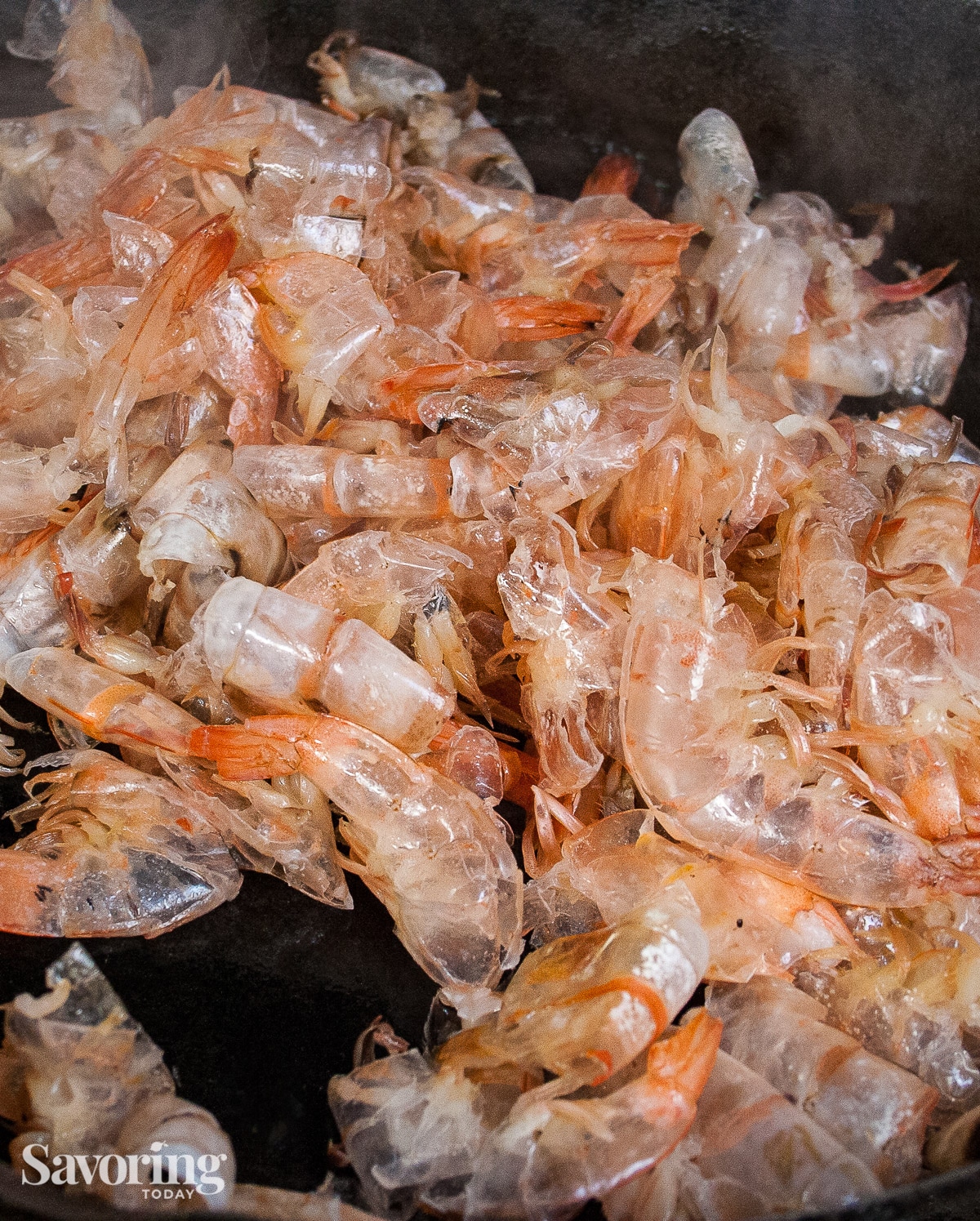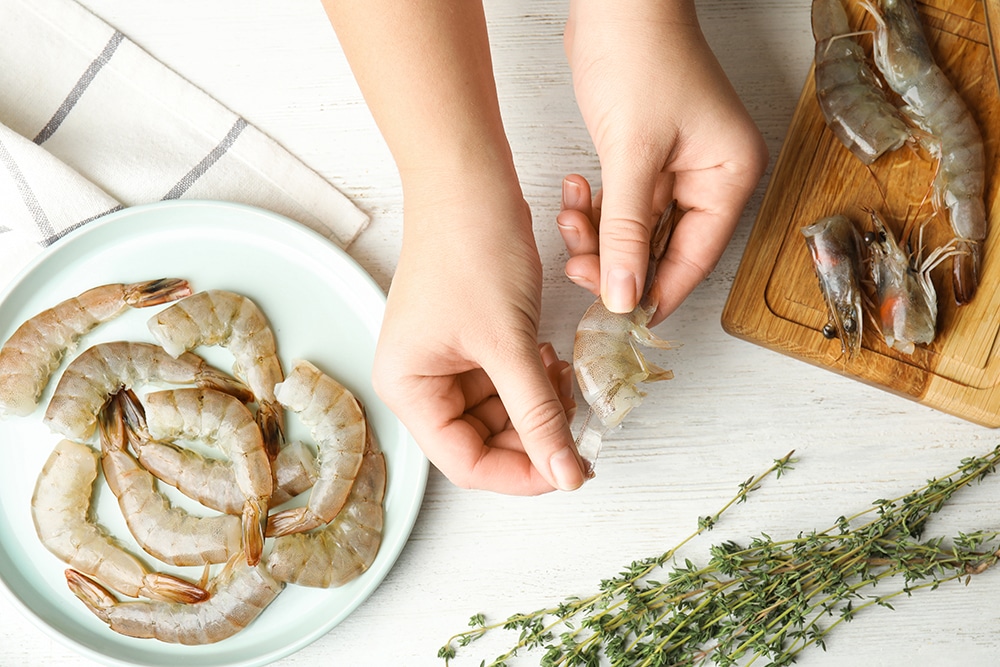Homemade shrimp stock is a crucial element in making the most delicious soups, gumbos, and stews.
It’s simple to make this stock, and it tastes great. Make a quick batch whenever you have fresh shrimp shells.
Homemade stock is a crucial element in delicious soups and stews. This recipe is inspired by Emeril’s Rich Shrimp Stock and is the base for Cajun Shrimp Stew.
Here in Colorado, it is not always easy to source shrimp with heads for the stock. The few shells from the shrimp for the Cajun stew were not enough for a great stock. To improvise, I asked for a fish head at the seafood counter, which they had.
Fish for most big grocery stores is now trimmed at a bigger facility and sent to them case-ready. It can depend on the time of year when scraps and carcasses are available, but a good fishmonger will usually have something in their freezer. It’s worth asking.
One to two pounds of shells to three to four quarts of filtered water is a good rule of thumb.
If you need shrimp stock quickly, you can use clam juice or crushed anchovies mixed with vegetable stock instead.
Homemade shrimp stock tastes best when kept in the fridge for three days or frozen for up to three months.
Store stock in a wide mouth jar (no shoulders), air-tight container, or freezer zip-type bag. If it’s still fresh, use it within three days. If not, freeze it for three months in containers with headspace or for up to six months in freezer bags without air.
Shrimp stock is a versatile base for seafood soups, risottos, and sauces. When made with shrimp heads, it has an incredibly rich, briny flavor that can elevate any dish. As a food blogger and home cook, I love experimenting with different stocks and broths to add complexity to my recipes. After tasting a phenomenal shrimp bisque at a local restaurant, I decided to try making shrimp stock at home with heads to recreate that intense seafood taste.
Through trial and error I’ve perfected a simple method for making shrimp stock that maximizes flavor. In this article, I’ll share my tips for making the best shrimp stock with heads. Whether you’re an experienced cook or completely new to making stock, you’ll learn techniques to draw out the most flavor from shrimp shells and heads. Let’s get started!
Why Use Shrimp Heads for Stock?
The heads of shrimp contain a high concentration of oils, fats, and flavor compounds. Simmering the heads slowly releases these substances into the water, creating an intensely flavorful shrimp broth. The shells add richness as well.
Many shrimp stock recipes call only for shells, but heads impart a far superior flavor. I highly recommend using heads if you can get your hands on them. Check with your local fish market to see if they have shrimp heads available. The small extra effort is well worth it for the best tasting shrimp stock.
Tips for Finding Shrimp Heads
If your regular grocery store or fish market doesn’t carry shrimp heads. here are some tips for sourcing them
-
Ask the seafood counter at your grocery store if they can order or save shrimp heads for you. Many stores receive whole shrimp to prepare in-house and can set heads aside.
-
Look for Asian or Hispanic markets in your area, which often sell whole shrimp. You can remove the heads yourself.
-
Order shrimp heads online through seafood retailers that ship on ice. Check reviews and only order from reputable companies.
-
If you regularly buy shell-on shrimp, save the heads and shells in freezer bags until you have enough to make stock.
Getting ahold of shrimp heads may take some effort, but it’s worth it! Even just 1⁄2 pound of heads makes a noticeable difference in flavor compared to shell-only stock.
Additional Tips for Maximizing Flavor
In addition to using heads, follow these tips when making shrimp stock:
-
Sauté the shells and heads first. Cooking them briefly in oil deepens the color and brings out nutty, savory notes.
-
Include shells from other crustaceans. For an extra briny, complex flavor, add a few shells from lobster, crab, or crawfish.
-
Simmer gently. High heat can make the stock cloudy. Keep it at a bare simmer for maximum clarity.
-
Skim the foam. Impurities will float to the top as scum. Remove promptly for a cleaner broth.
-
Strain well. Cheesecloth or a fine mesh strainer ensures no shell fragments end up in your stock.
-
Reduce slightly. Letting the strained stock simmer uncovered for 15-20 minutes concentrates the flavor.
Follow my complete recipe below for foolproof shrimp stock with heads that makes the most of their intense flavor.
Step-by-Step Instructions for Making Shrimp Stock with Heads
The process takes some time, but mostly involves passive simmering. Active prep time is less than 10 minutes. Here’s how to make about 6 cups of rich homemade shrimp stock:
Ingredients:
- 1 pound shrimp heads and shells
- 2 tablespoons olive oil
- 1 small onion, chopped
- 2 celery stalks, chopped
- 1 carrot, chopped
- 4 garlic cloves, smashed
- 1 bay leaf
- Small handful Italian parsley
- 1⁄2 teaspoon black peppercorns
- 6 cups water
Directions:
-
Rinse shrimp heads and shells under cold water and pat dry. Remove and discard the dark vein running down the back of the heads.
-
Heat olive oil in a large pot over medium heat. Add heads and shells and cook, stirring frequently, for 2-3 minutes until shells turn pink.
-
Add onion, celery, carrot, garlic, bay leaf, parsley, and peppercorns. Cook for 3 minutes, stirring occasionally, until vegetables soften slightly.
-
Add water and bring to a gentle simmer. Skim any foam that rises to the top.
-
Simmer stock uncovered for 45 minutes. Remove from heat and let stand for 15 minutes.
-
Strain stock through a fine mesh strainer lined with cheesecloth. Press gently on solids to extract liquid.
-
Return stock to clean pot. Simmer uncovered for 15-20 minutes until reduced slightly and concentrated in flavor.
-
Taste and season with salt if desired. Allow to cool completely before storing.
The stock keeps for up to a week in the fridge or 3 months in the freezer. Freeze in ice cube trays for easy portioning.
With an array of minerals and real shrimp flavor, homemade stock made with heads is leagues beyond anything from a box or can. Use it to make exquisite seafood risottos, stews, chowders, and more. The simple method yields a complex, restaurant-quality broth.

How to Boost Flavor in Fish Stock Without Fish Heads
If you don’t have enough shells, don’t worry! You can still make shrimp stock taste better by adding a little of the following:
- fish sauce
- bonito (we use this in Pad Thai too!)
- clam juice
- mashed anchovy
- fish base bouillon
Note: All of these flavor enhancers have sodium in them, so if you use any of them, leave out the salt in the recipe or add it at the end to taste the stock.
Giving the stock a few more minutes to reduce will also make the flavors stronger, but you might want to open a window so the smell doesn’t stay inside. (Just sayin’).

This post may contain affiliate links. See our disclosure policy for more information.
Strain and Cool
- Grab a rimmed baking sheet for the strained contents so they can cool completely before being thrown away when you’re ready to strain the stock.
- Take a 2 or 4-cup scoop and move the contents to a strainer that is precariously balanced over a bowl instead of trying to pour from a heavy pot with splashy hot bits.
- When you strain, don’t press on the contents; let gravity do the work to keep small bits of sediment from pushing through. *If the taste and texture sound good, you can eat the strained meat and vegetables that are left over.
- Cool the stock as quickly as possible if you’re not going to use it right away. Put it in the sink in a bath of ice water or add a few ice cubes and pour it into a shallow container. Allow it to cool for two to three hours. Don’t put hot stock in the fridge; it will cool the whole fridge down to levels that could be dangerous.
- Homemade shrimp stock tastes best when kept in the fridge for three days or frozen for three months.
- You can freeze the stock in different amounts, like ice cube tray squares (tablespoons), 1/2 cup, 1 cup, or 2 cups. For soups, 6 to 8 cups is the best amount.
- Not all the way to the top of the containers and jars should be filled with liquid, leaving an inch of space for it to grow. You should only put things in the freezer in glass jars with straight sides (no shoulders).
- It’s best to store food in freezer bags that can lie flat. Remove as much air as possible before sealing. Spread the filled bags out flat on a baking sheet with a lip so they don’t stick together.

- Freezing food in zip-top bags: Food in a freezer bag will almost always leak when it thaws, and I have learned that bags can’t be trusted—there’s always a weak spot.
- It’s important not to fill the bags too much—2-4 cups per quart bag and 6-8 cups per gallon bag works well and doesn’t put too much stress on the seams.
- After straining out the solids and throwing them away, cut the stock even more to save space in the freezer. If you need to, add water to the defrosted stock to make it less concentrated.
- Don’t defrost in a bowl of water unless you want your stock to become watered down, and don’t trust the corners of the bag. Instead, defrost on a pan with a lip to catch any leaks.
How to Make Shrimp Stock – HTK Tutorial
How do you make shrimp stock?
Pour the stock through a mesh strainer into a saucepan, pressing down on the shells until all the liquid is extracted. Taste and add a pinch of salt if necessary. Shrimp stock is great to use in paella, bisque, gumbo, and risotto. Use flavored oils such as garlic, basil, or sun-dried tomato oil to sauté the shells.
What are the side effects of eating shrimp?
Shrimp allergy can be identified from signs and symptoms that appear after consuming shrimp or smelling it, such as itching, the appearance of red plaques on the skin, swelling in the face, especially in the eyes and mouth, and in the throat creating the feeling of a lump in the throat.
Is shrimp stock easy to make?
This flavorful shrimp stock proves how quick and easy it is to make homemade stock. The recipe uses loads of herbs and spices and shrimp shells to build a stock that is loaded with layers of flavors. Shrimp stock is one of those ingredients that is always great to have on hand.
Can you make shrimp stock with shells?
If you have shrimp with shells, you can make shrimp stock. In a perfect world, you would live near the sea, or to a fishmonger good enough to stock shrimp with their heads on — and you’d use those heads for your shrimp stock. But alas, most of us do not. No worries, you can make a lovely shrimp stock at home using just shells.
